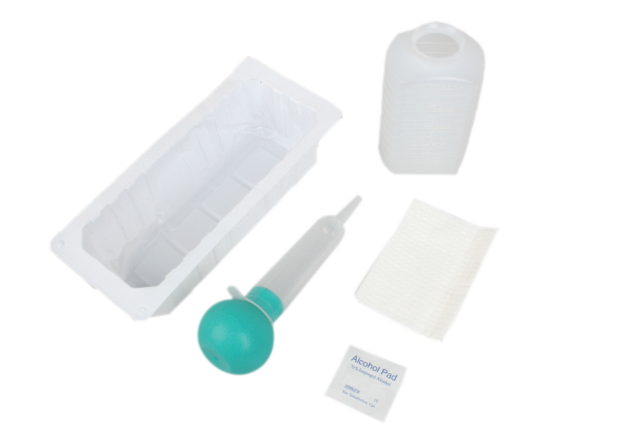
Irrigation Tray
If you're looking for a simpler, more convenient way to irrigate, then an irrigation tray might just be the solution for you. In this article, we'll take a close look at the various components of an irrigation tray, from the syringes and solution containers to the wipes and collection trays. You'll soon learn why these trays are practically indispensable for all your irrigation needs!
The lrrigation Syringe offers uninterrupted action in a Single- Hand technigue for maximum control of drawn or expelled volume. The barrel features raised, large and easy-to-read graduations.
Component:
1 1000cc Outer Tray
1 500cc Graduated Container
1 60cc Bulb lrrigation Syringe
1 Alcohol Prep Pad
1 Waterproof Underpad
An irrigation tray is a container that is used to hold water for irrigating plants. It is typically made of plastic or metal and has a series of small holes in the bottom for water to seep through. An irrigation tray is placed beneath a potted plant and allows the plant to receive a slow, steady supply of water without the need for frequent watering.
An irrigation tray is a great way to water your plants, especially if you have a lot of plants or a large garden. Here are some tips on how to use an irrigation tray:
1. Fill the tray with water. You can use tap water or rainwater.
2. Place the tray on a level surface.
3. Place your plants in the tray. Make sure that the roots are in the water.
4. Leave the plants in the tray for 30 minutes to 1 hour. This will allow them to absorb water through their roots.
5. Remove the plants from the tray and let them drain before replanting them in soil.
An irrigation tray is a small, shallow container that is used to water plants. They are typically made from plastic or metal and have a series of small holes in the bottom for drainage. Irrigation trays are an essential tool for anyone who wants to keep their plants healthy and hydrated. Irrigation trays are perfect for indoor or outdoor use. They can be used on balconies, patios, decks, or even inside your home. If you have a small space, an irrigation tray can help you water your plants without taking up too much space. Irrigation trays are also great for people who travel often or who have busy schedules. They allow you to water your plants quickly and easily without having to worry about over-watering them. If you are looking for an easy way to water your plants, an irrigation tray is the perfect solution. They are affordable, easy to use, and can be used in a variety of situations. Whether you have a large or small space, an irrigation tray can help you keep your plants healthy and hydrated.
When you are watering your plants, it is important to make sure that the roots are getting enough water. If the roots are not getting enough water, the plant will not be able to grow properly. The irrigation tray is a great way to make sure that your plants are getting enough water. The irrigation tray is a simple device that you can use to water your plants. It is a shallow tray that you can fill with water and then place your plants in. The roots of the plants will be able to soak up the water from the tray, and they will be able to get the moisture they need. The irrigation tray is a great way to water your plants, and it is a very affordable option. You can find these trays at most garden stores, and they are very easy to use. If you have never used one before, you should definitely try it out.
Irrigation trays are generally very versatile and can be used in a variety of situations. However, there are some instances where it is best to avoid using an irrigation tray. If the plants you are watering need large amounts of water, then an irrigation tray may not be able to provide enough water and may actually cause the roots to rot. It is also important to make sure that the plants you are watering with an irrigation tray are not too close together. If the plants are too close together, the water will not be able to evenly distribute and may end up damaging the roots.
Assuming you are using a basic irrigation tray, the process for cleaning it is as follows:
1. Remove all of the plants from the tray.
2. Rinse out the tray with clean water.
3. Use a mild soap or disinfectant to clean the tray, being sure to rinse away all residue afterwards.
4. Allow the tray to air dry completely before storing or using again.
When not in use, it is best to store your irrigation tray in a cool, dry place. If possible, keep it covered to protect it from dust and debris.